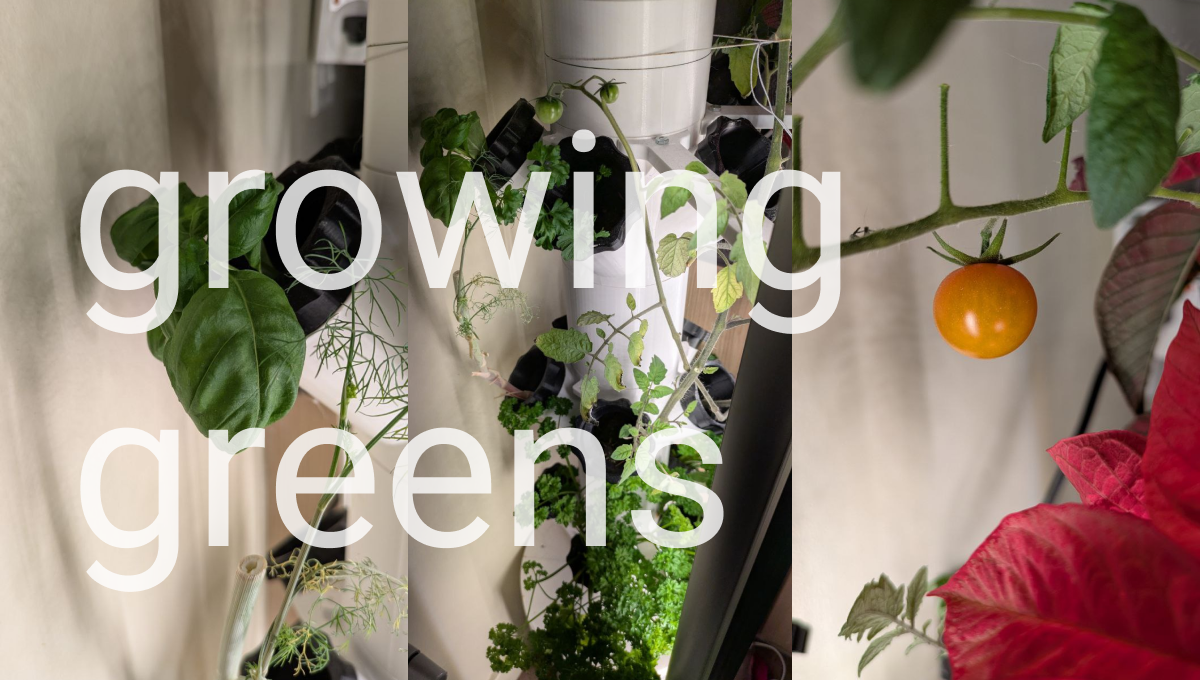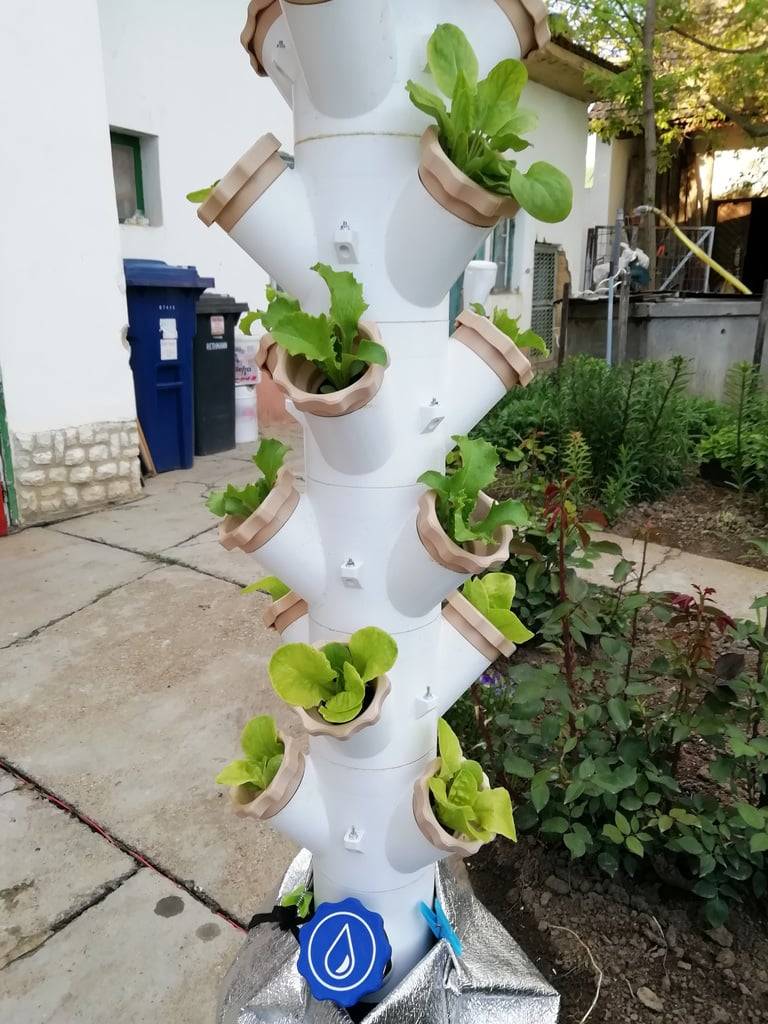Everything I've learned about aeroponics (so far)
3D-printed a vertical aeroponics tower: misted roots, 90% less water, fresh basil & tomatoes, saving big bucks (not really)

I'm on my path to figure out farming to grow everything I eat. I also live in Vancouver, which allows for a lengthy growing season, albeit not a year-long growing season. Obviously, I could use greenhouses to grow stuff, but I thought, what was the most modern way of farming? I went down the rabbit hole of hydroponics when I stumbled upon the newest fashion trend: vertical aeroponics farming. For a quick intro into what aeroponics is, watch some YouTube videos. Here's one I found after a quick search:
You can grow virtually anything with aeroponics, and it tastes great. One can claim that it can't be organic (because no soil), but if you use organic plant nutrients, I don't see how you're missing out on anything. Because my first hydroponic tower is indoors, I don't care about bugs—hence I don't use pesticides! I'm still questioning the microplastics content (the tower is PETG plastic), but I think it's within the same error margins as with growing stuff in soil.
Aeroponics is like hydroponics: you grow plants with a water-nutrient solution instead of soil. However, instead of constantly submerging roots in the solution, the solution is sprayed on the roots every hour (or so). This uses an order of magnitude less water.
I own a Bambu Labs A1 mini, so I opted for 3D printing the whole tower. Here're the designs and files I used (including my print profiles for some extra parts):

This is the most popular design, which has been remixed many times for better or worse. A1 mini has quite a small printing bed, so I had to print pieces of every plant holder separately. They didn't fit well (because the round shapes aren't actually round, due to mistakes in export by the people who remixed), and I used white silicone (you can buy it for like $10 from a hardware store) to seal each part of the assembly.
Nowadays, if I were to start over, I would make my tower from a food-safe plastic pipe (probably PVC or something; I don't know yet), shape it with a heat gun, and print the plant-holding inserts.
I opted for one spacer for every growing part, which worked out well to give the roots more space. I use AeroGarden liquid nutrients, and for the base 5-gallon food-safe bucket from Home Depot, I put roughly 30ml every time I change the water. I change the water every 3 weeks, so 1L of nutrients should last me approximately 1.5 years per tower.
Then, I took an aquarium pump and a food-grade tubing and connected them to a timer outlet that runs for one minute every hour between 6AM and 9PM. This basic setup worked until I learned a couple more lessons.
- You can't efficiently grow from seeds right in the tower. Use a germinator and transplant the plants to the tower only when they start touching the top of the germinator dome. Use rockwool grow cubes to grow and then transplant the plants into the tower plant inserts.
- Unless your tower is outside, you need more full-spectrum light. I got some grow lights and mounted two with the part I modelled and printed (available as a print profile in the MakerWorld link above). I also have them turn on and off on a timer.
Now, here's another gotcha: nutrient-rich water and a lot of light are good for the plants and the algae, too! Algae is challenging to get rid of, and I don't care enough to shield the 5-gallon water bucket from the lights, so I got some grapefruit seed oil and put two pipettes' worth of it every time I change the water. It doesn't stop all the algae growth, but it doesn't look too bad now. We need to get rid of algae because it can kill off the plants, which is not good.
My tower doesn't look so good because I accidentally turned off the pump for a week, killing most of the plant growth. It is slowly regrowing right now! In the meantime, I learned I can get way more tomatoes and basil plants without growing them from seeds! Here's how to get infinite basil.
Also, I learned about pruning tomatoes and basil to increase their growth. Besides them, I also grow dill, cilantro, and parsley. I eat many of these plants weekly, and my grocery bill is $30 per week cheaper.
I also got PH and PPM sensors, and I check the water mid-week to see if I need to top up nutrients. So far, I haven't needed this yet, but I might need to be topping up with more fruits popping up. PH is also very stable at 7 (tap water from a carbon filter that filters out microplastics). Even though they recommend a pH around 6.5, I find 7 suitable enough for the plant's growth.
What all these influencers pushing aeroponics onto people don't talk about is cleaning the tower. It's a tedious process, and I really don't want to disassemble all the pieces every three weeks. This is partly because roots get entangled in the parts of the assembly, and they will be hurt if torn away from them. So I don't do the complete disassembly, yet the process is tedious. I despise this task every time I see it in my planner.
I must remove the tower from the bucket and place it somewhere, usually on the floor. Then, I lift the bucket and pour it into the sink. Then, I brush off the algae from the bucket. Then, I refill the bucket and carry it back to the tower's location. Then, I add the nutrients and the grapefruit seed oil. Don't forget that I also wipe algae off the pump and the tubing dangling underneath the bare tower! Like, look at how tedious this is:
In the upcoming months, I will experiment with simply topping up the water and nutrients because this part of aeroponics is entirely unsustainable. And where do I put my veggies when I deep clean the tower? Do I start over every time I clean?
So far, even though I've hit almost every issue with aeroponics, I'm satisfied with the progress. I now get basil, grape tomatoes, cilantro, dill, and parsley virtually for free! Even better, I still have 45% of the tower unutilized, which I'll be working on next (planting more stuff).
Aeroponics is excellent because it requires very little oversight and can grow year-round indoors in virtually any climate. The amount of know-how available is limited (and kept very proprietary because tower manufacturers don't want you to know the secrets), so you must learn many things the hard way through trial and error.
But, in the end, the concept is sound and quite scalable: spray some nutrient solution on the roots hanging in the air, and boom, you get plant growth!


